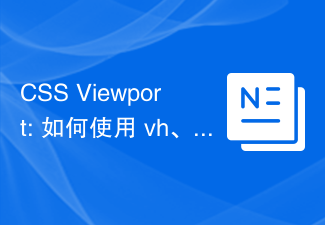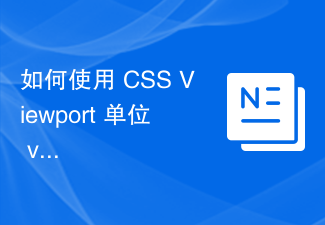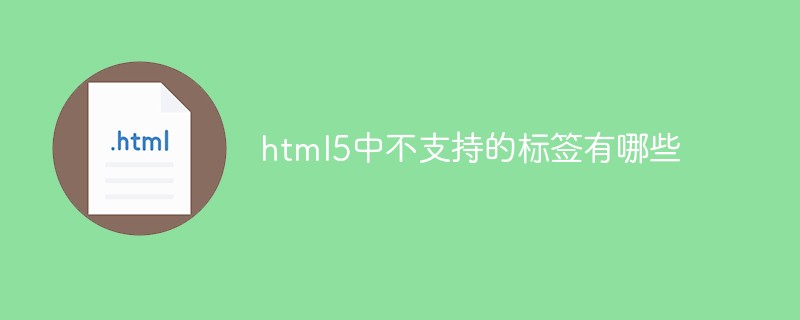This article is about viewport in HTML5. For students who are not familiar with viewport in HTML5, we can take a look at this article together! Let’s take a detailed look at the viewport in html5
To sum up, it just revolves around three questions:
1. Why set up a virtual window
Initially, it was to make the resolution of the virtual window close to that of the PC. In this way, the virtual window can still fully display the page content, but the page content is relatively small, and you need to manually zoom to see the page clearly.
2. What is the use of adding viewport
Adding viewport is to facilitate the optimization of the mobile terminal. Set the virtual window width to device-width, which is the same as the physical pixels of the device, so that we can control the display mode of the page mobile interface through media.
3. The relationship between the device screen width (that is, the physical pixels of the device) and the resolution
Taking the iPhone 6 as an example, the actual screen size is 375*667, but its resolution reaches 750*1334. The two are Different concepts.
Physical size refers to the actual size of the screen. A large screen must also be equipped with high resolution, that is, how many pixels can be displayed at this size. The more pixels displayed, the greater the room for expression. The screens of the two mobile phones are about the same size, but one can only display two lines of Chinese characters, while the other can display five lines of Chinese characters. Regardless of the difference in font size, the key is the resolution of the screen. The latter has a larger resolution, so naturally the same font can be used. More lines of Chinese characters can be displayed under different sizes. Color-screen mobile phones are indeed good, but without a large enough resolution screen performance, no matter how high the color quality is, what's the use.
Let’s explain the role of viewport and how it is combined with media.
A 50-pixel-wide p may be just right when displayed on a PC browser, but it will appear too large if displayed on a mobile browser. How to solve this problem? Apple found a way: it defined the viewport meta tag in the mobile version (iOS) of Safari. Its function is to create a virtual window (viewport), and the resolution of this virtual window is close to that of the desktop monitor. Apple positioned it is 980px. That is, when I open any page in the browser, the width of this page is 980px, not the physical width of the screen.
Taking Safari under the iPhone 6 as an example:
On the 375px physical screen of the iPhone 6 - visual viewport, a 980px virtual window - layout viewport (layout viewport) is created. In the visual window ( In the visual viewport), we can drag the horizontal and vertical slide bars or zoom in and out of the web page to achieve the best browsing effect (similar to a desktop browser); and the layout viewport is used to cooperate with CSS rendering layout, for example, when we set When the width of a container is 100%, the actual value of the container is 980px instead of 375px. In this way, most web pages can be displayed normally on the mobile phone screen in a zoomed form.
What is the actual size of the virtual window 980px on the screen?
The physical pixels of the iPhone 6 screen are 375px, and the width of the virtual window is 980px. The 1px size of the two is not to wait. To put it more simply, this px is not that px. One is used to describe the size of the actual window, that is, the visual window. One is used to describe the size of the virtual window, which has nothing to do with it. (You can use chromn to check the width of the page in PC browsers and mobile browsers.)
-
The virtual window sizes of safari browser, opera browser, and chromn browser are all 980px by default. FirefoxThe mobile mode is enabled by default, and its virtual window width is the device width.
After the smart phone creates a virtual window, another problem arises. After the PC web page is opened in the mobile browser, both the font and other elements appear relatively small, which makes it look difficult. Manual scaling seems more troublesome. Apple has also created a viewport to adjust the size of the virtual window. Generally, we will write
<meta name="viewport" content="width =device-width,initial-scale=1,user-scalable=1">
device-width to set the size of the virtual window to be equal to the physical pixel width of the device. This makes it easier for us to use media to write a page specifically adapted to the mobile terminal, so that we can see a page of the appropriate size on the mobile terminal.
The above is the detailed content of html5 viewport summary. For more information, please follow other related articles on the PHP Chinese website!
 html5的div一行可以放两个吗Apr 25, 2022 pm 05:32 PM
html5的div一行可以放两个吗Apr 25, 2022 pm 05:32 PMhtml5的div元素默认一行不可以放两个。div是一个块级元素,一个元素会独占一行,两个div默认无法在同一行显示;但可以通过给div元素添加“display:inline;”样式,将其转为行内元素,就可以实现多个div在同一行显示了。
 html5中列表和表格的区别是什么Apr 28, 2022 pm 01:58 PM
html5中列表和表格的区别是什么Apr 28, 2022 pm 01:58 PMhtml5中列表和表格的区别:1、表格主要是用于显示数据的,而列表主要是用于给数据进行布局;2、表格是使用table标签配合tr、td、th等标签进行定义的,列表是利用li标签配合ol、ul等标签进行定义的。
 CSS Viewport: 如何使用 vh、vw、vmin 和 vmax 单位来实现响应式设计Sep 13, 2023 pm 12:15 PM
CSS Viewport: 如何使用 vh、vw、vmin 和 vmax 单位来实现响应式设计Sep 13, 2023 pm 12:15 PMCSSViewport:如何使用vh、vw、vmin和vmax单位来实现响应式设计,需要具体代码示例在现代响应式网页设计中,我们通常希望网页能够适应不同屏幕尺寸和设备,以提供良好的用户体验。而CSSViewport单位(视口单位)就是帮助我们实现这一目标的重要工具之一。在本文中,我们将介绍如何使用vh、vw、vmin和vmax单位来实现响应式设
 如何使用 CSS Viewport 单位 vh 来创建适配手机屏幕的网页布局Sep 13, 2023 am 11:15 AM
如何使用 CSS Viewport 单位 vh 来创建适配手机屏幕的网页布局Sep 13, 2023 am 11:15 AM如何使用CSSViewport单位vh来创建适配手机屏幕的网页布局手机设备的普及和使用越来越广泛,越来越多的网页需要进行手机屏幕的适配。为了解决这个问题,CSS3引入了一个新的单位——Viewport单位,其中包括vh(viewportheight)。在这篇文章中,我们将探讨如何使用vh单位来创建适配手机屏幕的网页布局,并提供具体的代码示例。一
 html5怎么让头和尾固定不动Apr 25, 2022 pm 02:30 PM
html5怎么让头和尾固定不动Apr 25, 2022 pm 02:30 PM固定方法:1、使用header标签定义文档头部内容,并添加“position:fixed;top:0;”样式让其固定不动;2、使用footer标签定义尾部内容,并添加“position: fixed;bottom: 0;”样式让其固定不动。
 使用 CSS Viewport 单位 vh 和 vmin 创建媒体查询的技巧Sep 13, 2023 am 11:18 AM
使用 CSS Viewport 单位 vh 和 vmin 创建媒体查询的技巧Sep 13, 2023 am 11:18 AM使用CSSViewport单位vh和vmin创建媒体查询的技巧随着移动设备的普及,响应式设计已成为现代网页设计的必备技术。为了适应不同大小的屏幕,开发人员需要通过媒体查询来调整布局和样式。而在媒体查询中,最常用的单位是像素(px)。然而,CSS3引入了一种新的视窗单位,即vh和vmin,它们能够更好地适应不同设备尺寸。本文将介绍如何使用vh和v
 HTML5中画布标签是什么May 18, 2022 pm 04:55 PM
HTML5中画布标签是什么May 18, 2022 pm 04:55 PMHTML5中画布标签是“<canvas>”。canvas标签用于图形的绘制,它只是一个矩形的图形容器,绘制图形必须通过脚本(通常是JavaScript)来完成;开发者可利用多种js方法来在canvas中绘制路径、盒、圆、字符以及添加图像等。
 html5中不支持的标签有哪些Mar 17, 2022 pm 05:43 PM
html5中不支持的标签有哪些Mar 17, 2022 pm 05:43 PMhtml5中不支持的标签有:1、acronym,用于定义首字母缩写,可用abbr替代;2、basefont,可利用css样式替代;3、applet,可用object替代;4、dir,定义目录列表,可用ul替代;5、big,定义大号文本等等。


Hot AI Tools

Undresser.AI Undress
AI-powered app for creating realistic nude photos

AI Clothes Remover
Online AI tool for removing clothes from photos.

Undress AI Tool
Undress images for free

Clothoff.io
AI clothes remover

AI Hentai Generator
Generate AI Hentai for free.

Hot Article

Hot Tools

VSCode Windows 64-bit Download
A free and powerful IDE editor launched by Microsoft

DVWA
Damn Vulnerable Web App (DVWA) is a PHP/MySQL web application that is very vulnerable. Its main goals are to be an aid for security professionals to test their skills and tools in a legal environment, to help web developers better understand the process of securing web applications, and to help teachers/students teach/learn in a classroom environment Web application security. The goal of DVWA is to practice some of the most common web vulnerabilities through a simple and straightforward interface, with varying degrees of difficulty. Please note that this software

Notepad++7.3.1
Easy-to-use and free code editor

SecLists
SecLists is the ultimate security tester's companion. It is a collection of various types of lists that are frequently used during security assessments, all in one place. SecLists helps make security testing more efficient and productive by conveniently providing all the lists a security tester might need. List types include usernames, passwords, URLs, fuzzing payloads, sensitive data patterns, web shells, and more. The tester can simply pull this repository onto a new test machine and he will have access to every type of list he needs.

SublimeText3 Mac version
God-level code editing software (SublimeText3)






